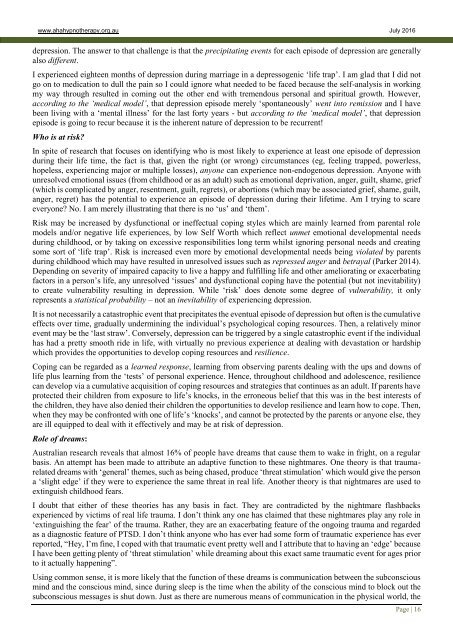The Australian Hypnotherapy Journal
296nlgS
296nlgS
You also want an ePaper? Increase the reach of your titles
YUMPU automatically turns print PDFs into web optimized ePapers that Google loves.
www.ahahypnotherapy.org.au July 2016<br />
depression. <strong>The</strong> answer to that challenge is that the precipitating events for each episode of depression are generally<br />
also different.<br />
I experienced eighteen months of depression during marriage in a depressogenic ‘life trap’. I am glad that I did not<br />
go on to medication to dull the pain so I could ignore what needed to be faced because the self-analysis in working<br />
my way through resulted in coming out the other end with tremendous personal and spiritual growth. However,<br />
according to the ‘medical model’, that depression episode merely ‘spontaneously’ went into remission and I have<br />
been living with a ‘mental illness’ for the last forty years - but according to the ‘medical model’, that depression<br />
episode is going to recur because it is the inherent nature of depression to be recurrent!<br />
Who is at risk?<br />
In spite of research that focuses on identifying who is most likely to experience at least one episode of depression<br />
during their life time, the fact is that, given the right (or wrong) circumstances (eg, feeling trapped, powerless,<br />
hopeless, experiencing major or multiple losses), anyone can experience non-endogenous depression. Anyone with<br />
unresolved emotional issues (from childhood or as an adult) such as emotional deprivation, anger, guilt, shame, grief<br />
(which is complicated by anger, resentment, guilt, regrets), or abortions (which may be associated grief, shame, guilt,<br />
anger, regret) has the potential to experience an episode of depression during their lifetime. Am I trying to scare<br />
everyone? No. I am merely illustrating that there is no ‘us’ and ‘them’.<br />
Risk may be increased by dysfunctional or ineffectual coping styles which are mainly learned from parental role<br />
models and/or negative life experiences, by low Self Worth which reflect unmet emotional developmental needs<br />
during childhood, or by taking on excessive responsibilities long term whilst ignoring personal needs and creating<br />
some sort of ‘life trap’. Risk is increased even more by emotional developmental needs being violated by parents<br />
during childhood which may have resulted in unresolved issues such as repressed anger and betrayal (Parker 2014).<br />
Depending on severity of impaired capacity to live a happy and fulfilling life and other ameliorating or exacerbating<br />
factors in a person’s life, any unresolved ‘issues’ and dysfunctional coping have the potential (but not inevitability)<br />
to create vulnerability resulting in depression. While ‘risk’ does denote some degree of vulnerability, it only<br />
represents a statistical probability – not an inevitability of experiencing depression.<br />
It is not necessarily a catastrophic event that precipitates the eventual episode of depression but often is the cumulative<br />
effects over time, gradually undermining the individual’s psychological coping resources. <strong>The</strong>n, a relatively minor<br />
event may be the ‘last straw’. Conversely, depression can be triggered by a single catastrophic event if the individual<br />
has had a pretty smooth ride in life, with virtually no previous experience at dealing with devastation or hardship<br />
which provides the opportunities to develop coping resources and resilience.<br />
Coping can be regarded as a learned response, learning from observing parents dealing with the ups and downs of<br />
life plus learning from the ‘tests’ of personal experience. Hence, throughout childhood and adolescence, resilience<br />
can develop via a cumulative acquisition of coping resources and strategies that continues as an adult. If parents have<br />
protected their children from exposure to life’s knocks, in the erroneous belief that this was in the best interests of<br />
the children, they have also denied their children the opportunities to develop resilience and learn how to cope. <strong>The</strong>n,<br />
when they may be confronted with one of life’s ‘knocks’, and cannot be protected by the parents or anyone else, they<br />
are ill equipped to deal with it effectively and may be at risk of depression.<br />
Role of dreams:<br />
<strong>Australian</strong> research reveals that almost 16% of people have dreams that cause them to wake in fright, on a regular<br />
basis. An attempt has been made to attribute an adaptive function to these nightmares. One theory is that traumarelated<br />
dreams with ‘general’ themes, such as being chased, produce ‘threat stimulation’ which would give the person<br />
a ‘slight edge’ if they were to experience the same threat in real life. Another theory is that nightmares are used to<br />
extinguish childhood fears.<br />
I doubt that either of these theories has any basis in fact. <strong>The</strong>y are contradicted by the nightmare flashbacks<br />
experienced by victims of real life trauma. I don’t think any one has claimed that these nightmares play any role in<br />
‘extinguishing the fear’ of the trauma. Rather, they are an exacerbating feature of the ongoing trauma and regarded<br />
as a diagnostic feature of PTSD. I don’t think anyone who has ever had some form of traumatic experience has ever<br />
reported, “Hey, I’m fine, I coped with that traumatic event pretty well and I attribute that to having an ‘edge’ because<br />
I have been getting plenty of ‘threat stimulation’ while dreaming about this exact same traumatic event for ages prior<br />
to it actually happening”.<br />
Using common sense, it is more likely that the function of these dreams is communication between the subconscious<br />
mind and the conscious mind, since during sleep is the time when the ability of the conscious mind to block out the<br />
subconscious messages is shut down. Just as there are numerous means of communication in the physical world, the<br />
Page | 16


